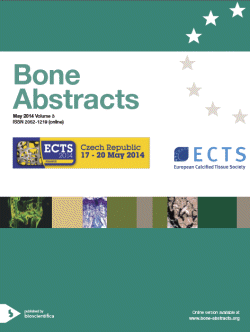
European Calcified Tissue Society Congress 2014
Prague,
Czech Republic
17 May 2014 - 20 May 2014

Poster Presentations
Arthritis and other joint diseases: translational and clinical
ba0003pp1 | Arthritis and other joint diseases: translational and clinical | ECTS2014
Mutual associations among diseases causing disability, such as musculoskeletal diseases, metabolic syndrome components, and mild cognitive impairment: a 3-year follow-up of the ROAD study
Yoshimura Noriko , Muraki Shigeyuki , Oka Hiroyuki , Tanaka Sakae , Kawaguchi Hiroshi , Nakamura Kozo , Akune Toru
ba0003pp2 | Arthritis and other joint diseases: translational and clinical | ECTS2014
Bone marrow lesions are characterized by increased bone turnover and increased vascularity
Shabestari Maziar , Vik Jarle , Reseland Janne , Eriksen Erik Fink
ba0003pp3 | Arthritis and other joint diseases: translational and clinical | ECTS2014
Bone loss in patients with early axial spondyloarthritis
Gubar Elena , Bochkova Anna , Smirnov Alexander , Dubinina Tatiana , Diomina Anastasia , Rumiantseva Oksana , Shubin Sergey , Glukhova Svetlana , Erdes Shander
ba0003pp4 | Arthritis and other joint diseases: translational and clinical | ECTS2014
Phenotypic and functional characterization of osteoclast progenitors in circulatory and synovial compartments of patients with rheumatoid arthritis
Sucur Alana , Jajic Zrinka , Ikic Marina , Ivcevic Sanja , Kelava Tomislav , Grcevic Danka
ba0003pp5 | Arthritis and other joint diseases: translational and clinical | ECTS2014
Regional differences in microstructural and mechanical properties of the distal femur in health and osteoarthritis
ba0003pp6 | Arthritis and other joint diseases: translational and clinical | ECTS2014
MIV-711, a highly selective cathepsin K inhibitor: safety, pharmacokinetics and pharmacodynamics of multiple oral doses in healthy postmenopausal women
Grabowska Urszula , Lindstrom Erik , Jerling Markus , Edenius Charlotte
ba0003pp7 | Arthritis and other joint diseases: translational and clinical | ECTS2014
Do osteophytes protect femoral neck against fracture in osteoarthritis?
Rabelo Gustavo Davi , Roux Jean Paul , Portero-Muzy Nathalie , Boutroy Stephanie , Chapurlat Roland , Chavassieux Pascale
ba0003pp8 | Arthritis and other joint diseases: translational and clinical | ECTS2014
Comparison of trabecular bone composition between osteoarthritis and non-osteoarthritis of distal femur by Raman spectroscopy
ba0003pp9 | Arthritis and other joint diseases: translational and clinical | ECTS2014
The characteristics of bone mineral density, erosive and destructive changes in joints of hands and feet, vertebral deformities in patients with rheumatoid arthritis
Petrova Elena , Dydykina Irina , Smirnov Aleksandr , Podvorotova Marina , Taskina Elena , Dydykina Polina , Nasonov Evgeniy
ba0003pp10 | Arthritis and other joint diseases: translational and clinical | ECTS2014
The influence of the 24-month treatment with anti-CD20 antibodies (rituximab) on bone mineral density in patients with rheumatoid arthritis
Dydykina Polina , Dydykina Irina , Devyataikina Anna , Lukina Galina , Smirnov Alexandr , Nasonov Evgeniy
ba0003pp11 | Arthritis and other joint diseases: translational and clinical | ECTS2014
Multinucleated giant cells in synovia from people with rheumatoid arthritis or osteoarthritis
Prieto-Potin Ivan , Largo Raquel , Roman-Blas Jorge A , Herrero-Beaumont Gabriel , Walsh David A
ba0003pp12 | Arthritis and other joint diseases: translational and clinical | ECTS2014
Cartilage oligomeric matrix protein assay on the IDS-iSYS automated system
Lorenzo Pilar , Manolopoulou Jenny , Seres Zoltan
ba0003pp13 | Arthritis and other joint diseases: translational and clinical | ECTS2014
RANK expression is reduced in circulating monocytes from ankylosing spondylitis patients
Perpetuo Ines Pedro , Caetano-Lopes Joana , Vieira-Sousa Elsa , Campanilho-Marques Raquel , Ponte Cristina , Canhao Helena , Ainola Mari , Fonseca Joao Eurico
ba0003pp14 | Arthritis and other joint diseases: translational and clinical | ECTS2014
Effect of risedronate on painful periprosthetic resorption of total hip arthroplasty: preliminary observational study
Behra-Marsac Aurelie , Bonnet Christine , Mabit Christian , Coste Cedric , Preux Pierre-Marie , Vergne-Salle Pascale , Dufauret-Lombard Carine , Treves Richard , Bertin Philippe
ba0003pp15 | Arthritis and other joint diseases: translational and clinical | ECTS2014
Bone secreted dickkopf-related protein 1 ameliorates osteoarthritis in mice
Funck-Brentano Thomas , Bouaziz Wafa , Marty Caroline , Geoffroy Valerie , Hay Eric , Cohen-Solal Martine



